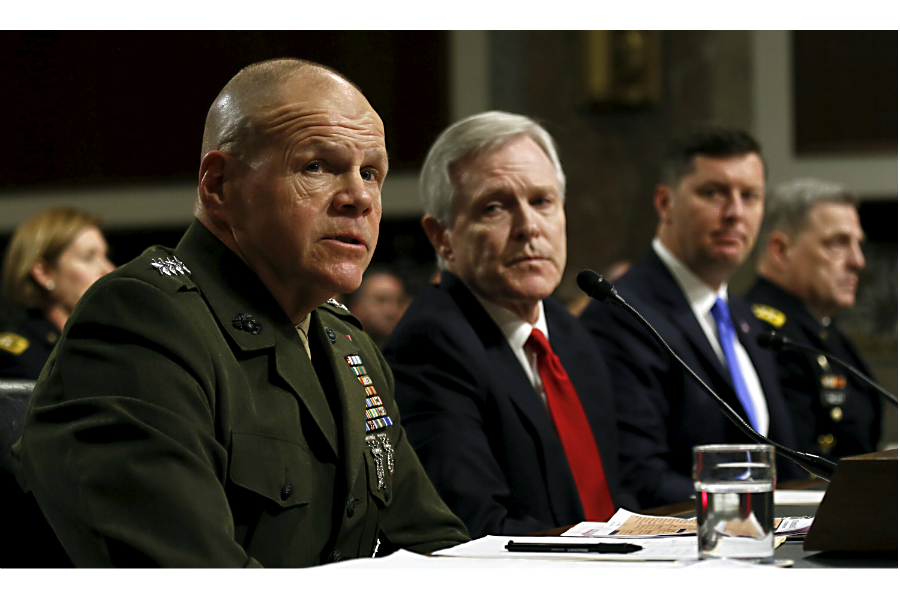Exclusive: Report shows Marines' shifting approach to women in combat
Loading...
| Washington
A yet-to-be-released Pentagon document obtained by the Monitor suggests that the Marines – long resistant to including women in combat units – are convinced that their concerns can be overcome.
When Secretary of Defense Ashton Carter opened combat positions to women last year, the Marine Corps asked for an exception to the policy, which was denied. Earlier, in arguing against the move, the Marines had published a controversial study that suggested women got injured more than men and were a detriment to unit morale.
But the Marines’ new gender Force Integration Implementation Plan (PDF) offers a more optimistic view, with Gen. Robert Neller promising that the corps “is stepping out smartly on this new mission.”
The plan does not dismiss the Marines’ earlier concerns, but suggests that “possible reductions in combat effectiveness can be addressed by effective leadership and gender neutral standards,” General Neller writes. “This has been demonstrated over the past 14 years in combat operations, during which women have played a critical role.”
The integration of women “may require a cultural shift in previously all-male career fields,” he acknowledges, but “we are prepared to meet this challenge.”
Neller and his colleague, Army Chief of Staff Gen. Mark Milley, were on Capitol Hill Tuesday for a hearing on women in combat. Senators both praised the decision to open combat jobs to women and worried about its implications – such as potentially requiring women to enter the draft.
“I am concerned that the department has gone about things backward,” said Sen. John McCain (R) of Arizona. “This consequential decision was made and mandated before the military services could study its implications.”
The female service members in attendance from Washington and abroad, wearing the medals they earned during their service overseas, took a different viewpoint.
Maj. Lisa Jaster, an Army Reserve officer and one of three women to graduate from Ranger School, was surrounded before the hearing began by fellow soldiers who came up to congratulate her, ask for advice, or simply hear some of her stories.
It was important to her to be at the hearing, Major Jaster says. “I wanted to hear firsthand that the military is planning on taking a deliberate and well-thought-out approach to integration” with “progress checks.” That women are capable of doing the job is clear, adds Jaster, whose favorite quote on the subject is from Lt. Gen. Jeffrey Talley, chief of the Army Reserve. He noted that the only reason 2015 saw the first three Ranger School graduates is that women weren’t allowed the chance to do it in 2014.
The women had high praise for General Milley, who early in the hearing expressed his unequivocal support for lifting all restrictions on women in combat who meet the standards.
“I have absolutely no doubt in my mind, in my professional judgment, that some women can perform every single job in the US Army,” he said.
Shelly Goode Burgoyne, an Army transportation officer who served two tours in Iraq as a convoy commander, flew from Mexico City to be there.
A longtime advocate for women in combat, she was “thankful” that Sen. Kirsten Gillibrand (D) of New York highlighted what she considers to be a “fundamental flaw” in the controversial Marine Corps study – comparing inexperienced female Marines with experienced male Marines.
“To me, it’s glaringly apparent that you can’t take a Marine with four months’ experience and expect her to perform at the level of a male sergeant who’s had 10 years of experience,” she says.
There were also murmurs of appreciation when Sen. Tim Kaine (D) of Virginia noted that the current record for solo hiking the 2,200-mile Appalachian Trail is held by a woman.
Neller, for his part, shared some personal moments. “I’ve got a daughter, and I’ve raised my daughter to be very competitive.”
He acknowledged, too, that in the Marine Corps study, units with women were better at problem solving than those without.
Jaster notes that some of the men in Ranger School adopted her method of packing her rucksack, putting the lighter items in the bottom and heavier weight on top. She found it was easier to carry weight this way, and many of the men agreed.
During her time at Ranger School, she says, she found her Ranger buddies to be supportive of integration, particularly as they got to know the women personally.
But at the hearing Tuesday, Neller repeatedly emphasized the physical differences between men and women. “The question is the extent to which we can mitigate that,” Neller said.
While the Marines’ Gender Integration Plan emphasized that those effects can be mitigated, the Marines appear to be putting a ceiling on the number of women in combat jobs, noting in their integration plan that “approximately 200 female Marines will access into ground combat arms” each year “and comprise fewer than 2 percent of steady state personnel in ground combat arms.”
Milley and Neller told lawmakers that they had submitted their gender integration plans to the secretary of Defense, and are awaiting approval.
“I really don’t know when,” Neller said, “but I expect it sometime in the relatively near future.”
After the hearing, Ms. Burgoyne said she was glad she made the trip. “I’ve been writing, screaming about this before it was even a possibility,” she says of lifting the ban on women in combat. She also endured some nasty comments and treatment. “It’s been a really long road, and we’re not at the end of it, but we’re close.”
For her, it was the chance to be part of a new chapter. “Meeting Jaster is amazing, and when I put a face to a name, it’s hard for me not to like Neller,” she says, even though she disagrees with him. “He’s decorated,” something a combat vet like Burgoyne says she admires and takes seriously.
Likewise, she adds, “It’s also important that they see us, too.”








